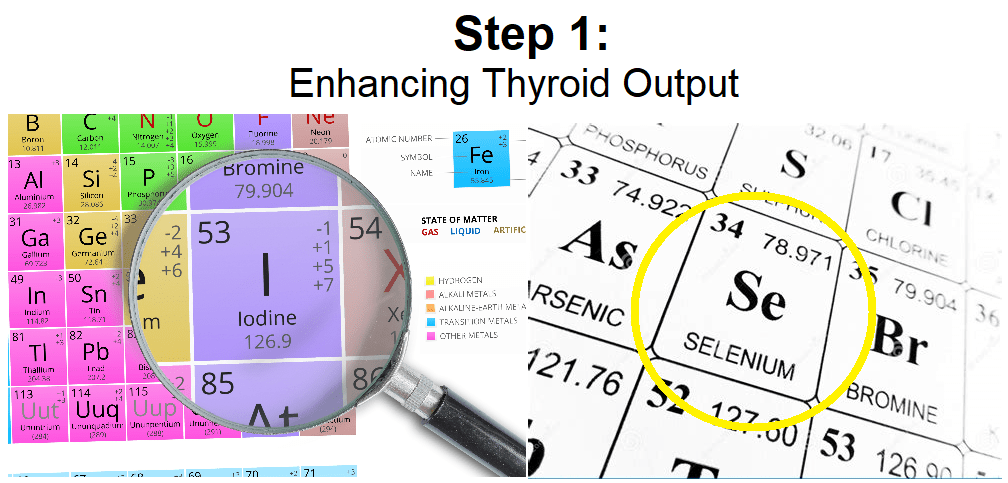
How to Use the B12 Protocol (Part 1): Iodide and Selenium
Share
This blog post is the first of a three-part series on how to use the B12 Protocol. In this series, we will cover the steps involved in fully implementing the B12 Protocol as a means of improving the Trifecta of health.
While there is no single correct order of implementation while using the vitamin B12 Protocol to repair methylation capacity, redox capacity, and mitochondrial health, this series will describe the most common order of doing it. Doing the steps in a different order is more likely to result in temporary, but unpleasant, side effects as a result of increasing demand for metabolic processes that require some preparatory steps to be in place.
If you implement all of the steps of the B12 Protocol, it should not have any different result in the end, and in that context, the order is not significant from a final result standpoint. However, to reduce or avoid negative symptoms while improving the components of the Trifecta, it is imperative that you make changes by listening to what your body (and lab testing) tells you. This order is the well-traveled path, if you will.
Step 1: Enhancing Thyroid Output with Iodide and Selenium
In the cascade of activating vitamin B2 (MTHFR's cofactor), thyroid hormones are critical because they regulate this activation process. As outlined in this paper, iodine and selenium are critical ingredients for the production of thyroid hormone. Absorption and utilization of these two key nutrients may be greatly improved by transdermal application of Iodide Oil and Selenium Oil, with countless anecdotal reports having suggested this.
These two ingredients are most often the limiting factor in optimizing thyroid hormone levels, so the first step of the B12 Protocol is often providing these two nutrients.
So which is first?
For most people, Iodide Oil should be introduced first, followed by Selenium Oil approximately 1-2 weeks later. This is because the thyroid produces thyroxine (T4) using iodide, then produces triiodothyronine (T3) with the help of a selenium-containing enzyme.

There is no hard and fast rule about waiting 1-2 weeks between dosing adjustments, but this is about how long it takes most people to feel the effect of a particular nutritional change on their mind and body. By allowing enough time to become conscious of the effect of a change, it gives the user a better understanding of how each product impacts them, which can be used to inform dosing.
For those who prefer a visual aid, your progression can take on a few different approaches, depending on how you respond.
Cautious approach #1 (alternating iodide titration and selenium titration):
|
|
Iodide (drops) |
Selenium (drops) |
|
Week 1 (daily) |
1 |
0 |
|
Week 2 (daily) |
1 |
1 |
|
Week 3 (daily) |
2 |
1 |
|
Week 4 and Thereafter (daily) |
2 |
2 |
Cautious approach #2 (iodide titration, followed by selenium titration):
|
|
Iodide (drops) |
Selenium (drops) |
|
Week 1 (daily) |
1 |
0 |
|
Week 2 (daily) |
2 |
0 |
|
Week 3 (daily) |
2 |
1 |
|
Week 4 and Thereafter (daily) |
2 |
2 |
Quicker approach (simultaneous titration of iodide and selenium):
|
|
Iodide (drops) |
Selenium (drops) |
|
Week 1 (daily) |
1 |
1 |
|
Week 2 and Thereafter (daily) |
2 |
2 |
A couple of things to point out here. While the quicker approach is appealing from a time-saving perspective, it removes the ability to feel the effect of Iodide Oil and Selenium Oil in isolation from each other. If you experience a negative reaction while following this time-saving approach, you may want to start from the beginning following one of the cautious approaches.
These examples end with the user getting RDA of both minerals. However, there is no way to predict how many drops you will require of each product to optimize thyroid hormone levels. Some people who have been deficient in either mineral for a long time may require higher doses until some of this mineral debt is reconciled in the body.
After maintaining these doses for 2-4 weeks, then testing your thyroid lab values, we want to see both fT4 and fT3 at least mid-range. If either value is below mid-range, you will want to increase your dose of iodide and/or selenium, respectively. Meaning, if fT4 is below mid-range, continue titrating Iodide Oil. And if fT3 is below mid-range, continue titrating Selenium Oil. Being above the high-end cutoff of the lab reference range usually suggests that you can reduce the amount of that particular mineral you are using.
While these three examples are the most common ways of embarking on the first step of the B12 Protocol, you may need to take a different approach if you are being treated for any type of autoimmune thyroid condition, such as Hashimoto's Disease. Of course, involve your treating physician in these decisions if that describes your situation, especially if you have been prescribed thyroid medication. Tapering off of thyroid medication by using these products is a topic that may be expanded upon in a future blog post.
If you have tested positive for elevated thyroid autoantibodies, it is better to begin with titrating Selenium Oil, followed by titrating Iodide Oil (when thyroid autoantibodies have reduced to acceptable levels). This is because selenium is needed to produce the antioxidant enzymes Glutathione Peroxidase and Thioredoxin Reductase. These selenium-containing enzymes help quench the peroxide residues produced in the thyroid. These peroxide residues trigger autoantibody production, so by quenching them, the level of autoantibodies can be kept in control and often reduced to acceptable levels. The use of supplemental inositol and an antioxidant supplement (such as Protocol Support) can speed up the process of lowering autoantibodies. There may also be a future blog post that gets into the topic of reducing thyroid autoantibodies in more detail.
Only after you have acceptable levels of thyroid autoantibodies should a person with autoimmune thyroiditis introduce Iodide Oil into their regiment. Autoantibodies should be routinely monitored by that patient's endocrinologist to make sure that iodide supplementation is being balanced with adequate antioxidant support and not triggering increased levels of autoantibodies.
Using Symptoms to Inform Dosing and Pace of Titration
The B12 Protocol has resulted in amazing transformations in health for so many children and adults. Often, it is reported that with addition of Iodide Oil and Selenium Oil, a child begins to experience the following transformations:
- reduction or elimination of blood and/or mucus in stool
- normalized stool frequency, volume, and consistency
- increased number of tolerated foods
- reduction or elimination in itchiness and/or skin rashes
- reduction or elimination of in eye swelling
- improved sleep
- improved language
- improved mood, demeanor, and cooperation
- and more
These effects are reported after just the first step of the B12 Protocol, with added benefits often reported as the protocol progresses.
While it is our goal to maximize the transformative effects listed above and avoid any negative "growing pains" while introducing the B12 Protocol, healing in any capacity often involves some discomfort, and we would be remiss to neglect mention of this possibility.
At Spectrum Sciences, we like to frame any negative adjustments as our body informing us of how to help us heal. In that sense, negative symptoms can be tremendously informative, though admittedly physically challenging.
In the early stages of introducing Iodide Oil and/or Selenium Oil, you may or may not experience some temporary yet uncomfortable symptoms that can range in severity from unnoticeably mild to very uncomfortable. These symptoms are often referred to in the B12 community as "startup symptoms" and resemble the exact opposite of the transformative effects mentioned above, which may include any of the following:
- Hyperactivity
- Disrupted sleep
- Gastrointestinal symptoms
- Mild neurological symptoms
- Mood changes
- Sensory symptoms
- Cardiovascular symptoms
- Flu-like physical symptoms
Again, these are temporary, relatively rare (though more common in the medically-complex child), and usually very mild when they occur. Increasing intake of potassium is often reported to help mitigate some of these side effects as well.
To help differentiate between whether these symptoms are related to iodide or selenium, there seem to be some symptoms more commonly attributed to one or the other.
If you experience any unexplained symptoms from the list below, it may suggest you should increase Selenium Oil (or reduce Iodide Oil):
- Nasal congestion
- Nasal discharge
- Sneezing
- Unproductive coughs
- Feeling of tightness in the lungs
- Itching (itchy eyes, skin, etc.)
- Swollen lymph nodes
- Sore throat
- Throat tightness
- Eyelid swelling
- Red eyelids
- Waking up earlier than usual
- Difficulty falling asleep
- Frequent urination
- Excessive urination
- Frequent stools
- Runny stools
- Stomach pains
- Unexplained fever
- Increased anxiety
For the symptoms listed above that seem to be adrenaline-like, you may experience some relief from simply increasing potassium intake. Since this is usually a wise health choice anyhow, it makes sense to try that approach first before making any adjustments to iodide and/or selenium.
If you experience any unexplained symptoms from the list below, it may suggest you should increase Iodide Oil (or reduce Selenium Oil):
- Burning lips
- Amenorrhea
- Infrequent urination
- Reduced urinary volume
- Constipation
- Reflux
It is best to take symptoms and lab testing equally into consideration when deciding on how to dose Iodide Oil and Selenium Oil.
Final Thoughts
While this blog post has not covered all of the ins and outs of enhancing thyroid output with Iodide Oil and Selenium Oil, it covers a lot of ground.
If you need additional help navigating the use of Iodide Oil and/or Selenium Oil in the context of the B12 Protocol, you can arrange one-on-one coaching.
We hope you have learned something useful from this blog post. Spectrum Sciences is committed to bringing you the information that you need in order to make informed decisions about your health. We are also determined to bring you the best Vitamin B12 supplement by various means, including protocol enhancement and new product offerings.
In the next installment of this three-part series, we will cover Step 2 of the B12 Protocol: Taking Functional Vitamin B2 Status to the Next Level!
